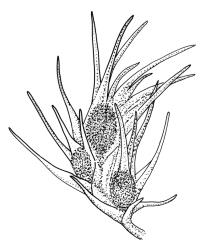Elements in the following description are taken from Ireland (1994).
Plants medium-sized to robust, bright green, yellow-green, or red-tinged, forming cushions or tufts, often with terete microphyllous branches in leaf axils, in cross-section with a few thick-walled outer cell layers and a distinct central strand (in N.Z. species). Stems unbranched or branched by forking, densely tomentose. Leaves variably oriented when moist, contorted or not when dry, acuminate from an ovate or oblong base, entire or weakly toothed, tubulose below and U-shaped or keeled above; mid laminal cells irregularly rounded, quadrate, or rectangular, smooth or bulging, mostly incrassate, sometimes sinuose or pitted; cells of the leaf base rectangular or linear, thick-walled and ± porose; alar cells strongly differentiated and pigmented, inflated, often extending to the costa. Costa variable in width, percurrent or nearly so, or sometimes filling the upper leaf, smooth or toothed on abaxial surface, in mid leaf cross-section with 2 stereid bands. Tubers lacking. Axillary filaments not seen in N.Z. species.
Dioicous (nearly always pseudautoicous). Perichaetia strongly sheathing, the leaves usually with long setaceous apices. Setae elongate and slender; capsules erect and symmetric or ± curved, not strumose, smooth, pale brown or yellow; mouth transverse; annulus not differentiated; operculum rostrate. Peristome teeth paired (in N.Z. species), undivided and perforate, or divided ± to base, papillose-baculate throughout. Calyptra cucullate and smooth. Spores spherical or ovoid.
A genus of some 50–70 species distributed mainly in tropical regions, and most diverse in tropical America. The genus is characterised by having erect and ± cylindric capsules with papillose peristome teeth, which are mostly not or only weakly split (except in H. trichopodum, where they are deeply divided). The presence of dwarf ♂ plants epiphytic upon the ♀ plants (pseudautoicy) and the frequent occurrence of microphyllous branches in most species are also a feature of the genus (Ireland 1994). The majority of species occur on tree trunks or rocks. Allen (1990) has discussed the genus for tropical America. The traditional concept of Holomitrium was expanded by Klazenga (2006), who has argued for the transfer of the systematically problematic Australasian species Dicranum trichopodum Mitt. to Holomitrium, despite its possession of unequally divided peristome teeth. Klazenga’s generic assignment is followed here and discussed further below.
| 1 | Microphyllous shoots often present in axils of upper leaves; leaves strongly contorted and inrolled when dry, ± abruptly tapered from an obovate-elliptic base to a tubulose upper leaf and a narrowly acuminate apex, entire throughout or crenulate to weakly toothed at shoulder; costa filling c. ⅙ or less of the leaf base and not filling the upper leaf; peristome teeth undivided or weakly divided for c. ⅓ their length | H. perichaetiale |
| 1' | Microphyllous shoots lacking; leaves not contorted when dry, narrowly ovate-lanceolate, evenly tapered to a long subulate and ± tubulose acumen, usually with a few ± spinose teeth at apex; costa filling c. ⅓ the leaf base and filling the upper half of leaf; peristome teeth unequally divided nearly to their base | H. trichopodum |
| Category | Number |
|---|---|
| Indigenous (Non-endemic) | 2 |
| Total | 2 |




